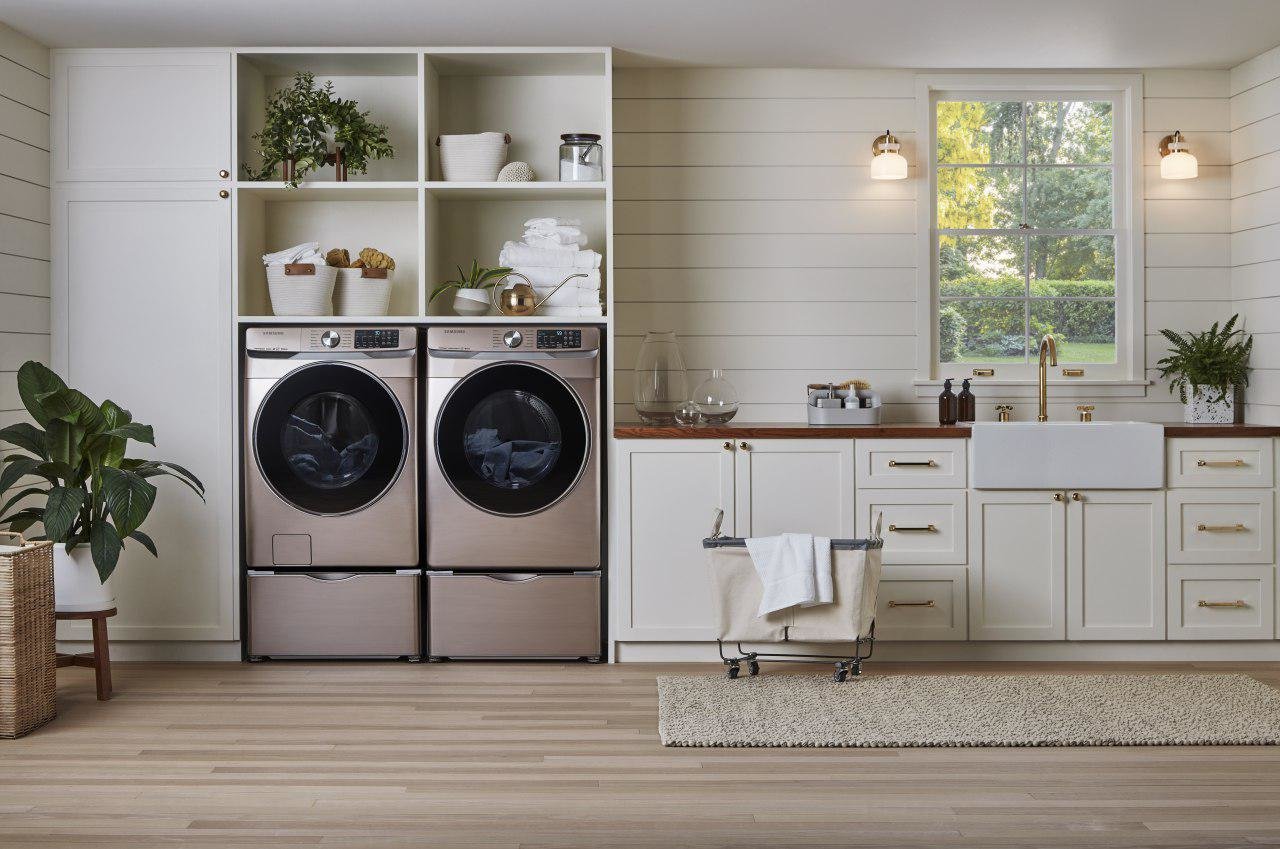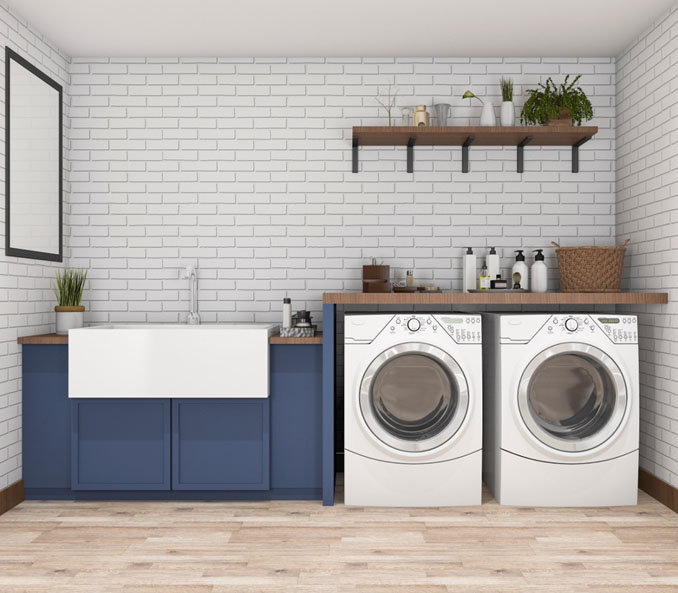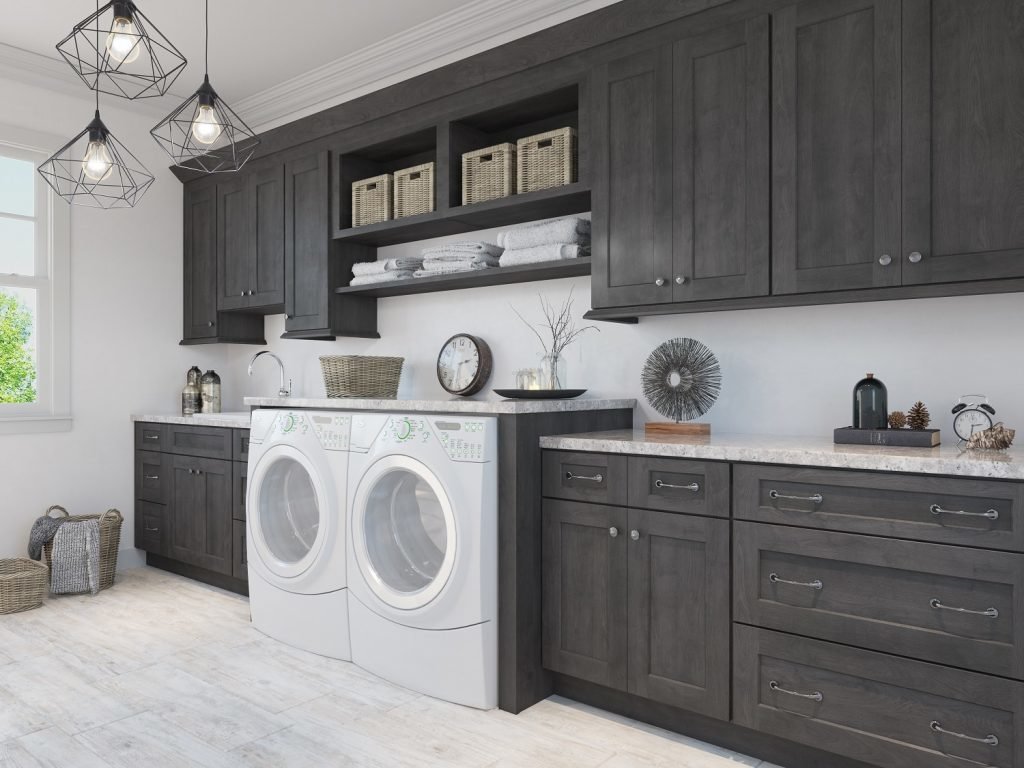
IN MY DREAMS, my laundry room is airy and bright, with wooden folding tables and shelves with baskets to intelligently organize detergents, sewing supplies, my ironing board and clothespins. In other words, it would resemble a modest-size Apple store, except with a whole section devoted to orphan socks.
But the laundry room in my reality is a hellhole. It’s a tiny closet, actually, where space is so tight I can barely close the door on the stacked machines that I jammed in there. They hulk, stupidly, among other random items including the vacuum, an empty guitar case and a weird bed coverlet known as “the meat blanket” because its mottled pink-and-white pattern resembles a slice of Mortadella sausage.
#laundryroomporn—photos of cramped spaces transformed into visions of utilitarian-luxe—is a hot topic on Instagram.
Worst of all, though, is the washing machine, which smells like mildew because its rubber seal is a moisture trap—a defect I came to learn over the past eight years is common in front loaders, and in this model in particular.
So it was actually good news a few weeks ago when the washer broke.
“Mrmffk, grnnnn…faulty shut-off valve,” the masked repairman seemed to say through his N95 mask. He also managed to convey to me that fixing the problem would cost upward of $600—nearly as much as I paid for the machine when it was new.
Maybe it was time to replace the washer and rethink the décor of the entire space?
After all, #laundryroomporn is a hot topic on Instagram, with hundreds of thousands of people posting clever ways to transform sad, cramped spaces into cleverly designed visions of utilitarian-luxe. Custom-painted cabinetry. Patterned William Morris wallpaper. Clothes-folding counters so softly illuminated by recessed lighting they look more like day spas than laundromats.

It turns out that laundry rooms have come a long way since the first automatic, electric clothes washer hit the market in 1937, a year before tumble dryers arrived on the scene. Noisy and prone to “walking” across the floor, those monsters spent decades bolted down in basements and garages before they became quiet enough to be invited into kitchens and mud rooms on the first floors of suburban homes.
Nowadays, having a separate laundry room with a door that can be shut is at the top of home buyers’ wish lists nationwide. In a recent survey of more than 3,000 home buyers, 87% ranked a desire for a laundry room above 195 other features—including hardwood floors, patios and walk-in pantries, said Rose Quint, an economist at the National Association of Home Builders. The reason? “People no longer want to walk over their dirty laundry piled up in the kitchen on the floor,” she said.
Renters also are willing to pay a premium for a laundry room. “In 2020, in metro areas across the country there was an average rent difference of about 44%—which is huge—for in-unit laundry,” said Zillow economist Jeff Tucker.
At the high end of the real-estate market, “a beautiful laundry room has become a status symbol,” said Leonard Steinberg, a real-estate broker at Compass in New York City. “I had a very well-to-do client who bought a loft in Tribeca with a 350-square-foot laundry room, and she put chairs in there so she could sit and watch her clothes dry. I think the appeal is that in a world where so little gets completed, in an hour or two you can get your clothes dried and folded, and you feel a sense of accomplishment.”
Mr. Steinberg said clients increasingly want luxurious laundry rooms that boast such amenities as free-standing steam closets—like the LG Styler ($1,198) and Samsung’s AirDresser ($1,149) to remove wrinkles and “refresh” fabrics.
“If you have the space, another feature that is coming back in a big way is a roller iron that does sheets,” Mr. Steinberg said.
“Like an old-fashioned mangle?” I asked. Because I am not afraid to show off my excellent vocabulary.

“Yes, some people are saying, ‘I don’t need a wine cellar; I’d rather have beautiful sheets,” he said. “But the biggest appeal now is to have the convenience of twin washer-dryers—two each, stacked—if you have the space for it. It’s like having two dishwashers.”
“You’d need a laundry room as big as a medium-size Apple store for all that,” I said wistfully. “Is there any way to fake the feeling of a luxurious laundry room in, say, a small closet?”
“People are getting very creative with laundry closets too,” he said. “With 10 to 15 square feet, you can fit in a lot of stuff—pullout rods, an ironing board attached to the door that folds down—if the space is very detailed.”
Inspired to get creative, a few days later I consulted a California Closets designer—only to learn that the company’s standard sizes of drawers and shelving inserts are not flexible. For a tiny laundry closet, a custom solution is a better choice, interior designers say.
Emily Pinney, an interior designer in Boston, frequently transforms tiny spaces into jewel-box laundry rooms with features including custom drying drawers (lined with chicken wire to promote aeration) and hinged backsplashes to hide the water supply shut-offs. “I’m working on one right now in the city, an old bathroom probably about 15 square feet that’s being converted into a laundry room. I’m using hand-painted wallpaper,” she said. “It’s all about taking a little risk and having a little fun.”
“So there’s hope for my tiny, windowless laundry closet?” I asked.
“You can get a really beautiful light fixture, a dramatic one to shine and sparkle in the room,” she said.
A sparkly ceiling fixture might brighten up my closet. After I hung up, I opened the laundry closet door, jumped back to avoid being hit by the stepladder that came tumbling out, and surveyed the possibilities. Compact laundry machines (so-called European-size models are from 3 to 6 inches narrower than full-size behemoths) would be a good start, to make room for more shelving.
But was there also a way to take a little risk and have a little fun? I unfurled my tape measure and—yes! There would be room to build a custom slot to neatly store the ironing board next to the laundry machines. And if I installed shelving, I could leave sufficient floor space for a stylish rattan hamper—on wheels!
Giddily, I put the meat blanket in a bag to take to Goodwill.
Article By Jan. 20, 2021 11:14 am ET for WSJ

Leave A Comment